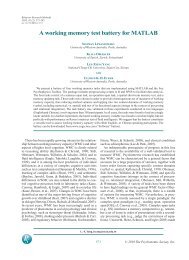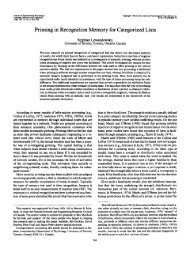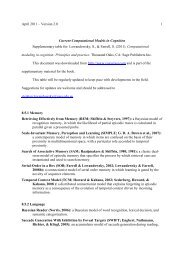Context effects in repetition priming are sense effects
Context effects in repetition priming are sense effects
Context effects in repetition priming are sense effects
Create successful ePaper yourself
Turn your PDF publications into a flip-book with our unique Google optimized e-Paper software.
626 BAINBRIDGE, LEWANDOWSKY, AND KIRSNER<br />
for new associations <strong>in</strong> normal and amnesic subjects. Journal ofErperimental<br />
Psychology: Learn<strong>in</strong>g, Memory, & Cognition, 11, 50l~518.<br />
GRAF, P., & SCHACTER, D. L. (1987). Selective <strong>effects</strong> of <strong>in</strong>terference<br />
on implicit and explicit memory for new associations. JournalofExperimental<br />
Psychology: Learn<strong>in</strong>g, Memory, & Cognition, 13, 45-53.<br />
GRAF, P., & SCHACTER, D. L. (1989). Unitization and group<strong>in</strong>g mediate<br />
dissociations <strong>in</strong> memory for new associations. Journal of Erperimental<br />
Psychology: Learn<strong>in</strong>g, Memory, & Cognition, 15, 930-940.<br />
HAMANN, S. B. (1990). Level-of-process<strong>in</strong>g <strong>effects</strong> <strong>in</strong> conceptually<br />
driven implicit tasks. JournalofExperimental Psychology: Learn<strong>in</strong>g,<br />
Memory, & Cognition, 16, 970-977.<br />
JACOBY, L. L. (1983). Remember<strong>in</strong>g the data: Analyz<strong>in</strong>g <strong>in</strong>teractive<br />
processes <strong>in</strong> read<strong>in</strong>g. Journal of Verbal Learn<strong>in</strong>g & Verbal Behavior,<br />
22, 485-508.<br />
JACOBY, L. L., & DALLAS, M. (1981). On the relationship between autobiographical<br />
memory and perceptual learn<strong>in</strong>g. Journal ofExperimental<br />
Psychology: General, 110, 306-340.<br />
JORGENSEN, J. C. (1990). The psychological reality of word <strong>sense</strong>s.<br />
Journal of Psychol<strong>in</strong>guistic Research, 19, 167-190.<br />
KIRSNER, K., & DUNN, J. C. (1985). The perceptual record: A common<br />
factor <strong>in</strong> <strong>repetition</strong> prim<strong>in</strong>g and attribute retention. In M. I. Posner<br />
& 0. 5. M. Mann (Eds.), Attention and performance XI (pp. 547-<br />
565). Hillsdale, NJ: Erlbaum.<br />
KOLERS, P. A., & ROEDIGER, H. L., 111(1984). Procedures of m<strong>in</strong>d.<br />
Journal of Verbal Learn<strong>in</strong>g & Verbal Behavior, 23, 425-449.<br />
KU~ERA, H., & FRANCIS, W. N. (1967). Computational analysis of<br />
present-day American English. Providence, RI: Brown University<br />
Press.<br />
LEVY, B. A., & KIRSNER, K. (1989). Reprocess<strong>in</strong>g text: Indirect measures<br />
of word and message level processes. Journal ofExperimental<br />
Psychology: Learn<strong>in</strong>g, Memory, & Cognition, 15, 407-417.<br />
LEWANDOWSKY, S., KIRSNER, K., & BAINBRrnGE, J. V. (1989). <strong>Context</strong><br />
<strong>effects</strong> <strong>in</strong> implicit memory: A <strong>sense</strong>-specific account. In S. Lewandowsky,<br />
J. C. Dunn, &K. Kirsner (Eds.), Implicit memory: Theoretical<br />
issues (pp. 185-198). Hillsdale, NJ: Erlbaum.<br />
MACLEOD, C. M. (1989). Word context dur<strong>in</strong>g <strong>in</strong>itial exposure <strong>in</strong>fluences<br />
degreeof prim<strong>in</strong>g <strong>in</strong> word fragment completion. Journalof<br />
Experimental Psychology: Learn<strong>in</strong>g, Memory, & Cognition, 15,<br />
398-406.<br />
MASSON, M. E. J., & FREEDMAN, L. (1990). Fluent identification of<br />
repeated words. JournalofExperimental Psychology: Learn<strong>in</strong>g, Memory,<br />
& Cognition, 16, 355-373.<br />
MASSON, M. E. J., & MACLEOD, C. M. (1992). Re-enact<strong>in</strong>g the route<br />
to <strong>in</strong>terpretation: Enhanced perceptual identification without prior perception.<br />
Journal ofExperimental Psychology: General, 121, 145-176.<br />
MILLIS, M. L., & BUTTON, S. B. (1989). The effect of polysemy on<br />
lexical decision time: Now you see it, now you don’t. Memory & Cognition,<br />
17, 141-147.<br />
MONSELL, S. (1985). Repetition and the lexicon. In A. W. Ellis (Ed.),<br />
Progress <strong>in</strong> the psychology oflanguage (Vol. 2, pp. 147-195). Hillsdale,<br />
NJ: Erlbaum.<br />
MoRTON, J. (1979). Word recognition. In J. Morton & J. C. Marshall<br />
(Eds.), Psychol<strong>in</strong>guistics: 2. Structure and processes. Cambridge, MA:<br />
MIT Press.<br />
OLIPHANT, G. W. (1983). Repetition and recency <strong>effects</strong> <strong>in</strong> word recognition.<br />
Australian Journal of Psychology, 35, 393-403.<br />
O’SEAGHDHA, P. G. (1989). The dependence of lexical relatedness <strong>effects</strong><br />
on syntactic connectedness. Journal of Experimental Psychology:<br />
Learn<strong>in</strong>g, Memory, & Cognition, 15, 73-87.<br />
ROEDIGER, H. L., III, & BLAXTON, T. A. (1987). Effects of vary<strong>in</strong>g<br />
modality, surface features, and retention <strong>in</strong>terval on prim<strong>in</strong>g <strong>in</strong> wordfragment<br />
completion. Memory & Cognition, 15, 379-388.<br />
ROEDIGER, H. L., III, SRINIVAS, K., & WELDON, M. S. (1989). Dissociations<br />
between implicit measures of retention. In S. Lewandowsky,<br />
J. C. Dunn, & K. Kirsner (Eds.), Implicit memory: Theoretical issues<br />
(pp. 67-84). Hillsdale, NJ: Erlbaum.<br />
SANOCKI, T., & ODEN, G. C. (1984). <strong>Context</strong>ual validity and the <strong>effects</strong><br />
of low-constra<strong>in</strong>t sentence contexts on lexical decisions. Quarterly<br />
Journal of Experimental Psychology, 36A, 145-155.<br />
SCARBOROUGH, D. L., CORTESE, C., & SCARBOROUGH, H. 5. (1977).<br />
Frequency and <strong>repetition</strong> <strong>effects</strong> <strong>in</strong> lexical memory. Journal ofExperimentalPsychology:<br />
Human Perception & Performance, 3, 1-17.<br />
SCHACTER, D. L. (1987). Implicit memory: History and current status.<br />
Journalof Experimental Psychology: Learn<strong>in</strong>g, Memory, & CognitiOn,<br />
13, 501-518.<br />
SCHUBERTH, R. E., SPOEHR, K. T., & LANE, D. M. (1981). Effects<br />
of stimulus and contextual <strong>in</strong>formation on the lexical decision process.<br />
Memory & Cognition, 9, 68-77.<br />
SIMPsoN, G. B. (1981). Mean<strong>in</strong>g dom<strong>in</strong>ance and semantic context <strong>in</strong><br />
the process<strong>in</strong>g of lexical ambiguity. Journal of Verbal Learn<strong>in</strong>g &<br />
Verbal Behavior, 20, 120-136.<br />
SMITH, M. C., MACLEOD, C. M., BAIN, J. D., & HOPPE, R. B. (1989).<br />
Lexical decision as an <strong>in</strong>direct test of memory: Repetition prim<strong>in</strong>g<br />
and list wide prim<strong>in</strong>g as a function of type of encod<strong>in</strong>g. Journal of<br />
Experimental Psychology: Learn<strong>in</strong>g, Memory, & Cognition, 15,<br />
1109-1118.<br />
TAB0SSI, P. (1988). Effects of context on the immediate <strong>in</strong>terpretation<br />
ofunambiguous nouns. Journalof Experimental Psychology: Learn<strong>in</strong>g,<br />
Memory, & Cognition, 14, 153-162.<br />
TABOSSI, P., & J0HNs0N-LAIRD, P. N. (1980). L<strong>in</strong>guistic context and<br />
the prim<strong>in</strong>g ofsemantic <strong>in</strong>formation. Quarterly JournalofExperimental<br />
Psychology, 32, 595-603.<br />
TULvING, E., SCHACTER, D. L., & STARK, H. A. (1982). Prim<strong>in</strong>g <strong>effects</strong><br />
<strong>in</strong> word-fragment completion <strong>are</strong> <strong>in</strong>dependent of recognition<br />
memory. Journalof Experimental Psychology: Learn<strong>in</strong>g, Memory,<br />
& Cognition, 8, 335-342.<br />
Webster’s new world dictionary of the American language (2nd ed.)<br />
(1979). Cleveland, OH: William Coll<strong>in</strong>s.<br />
NOTE<br />
1 We have chosen to differentiate between “mean<strong>in</strong>g” and “<strong>sense</strong>”<br />
to ma<strong>in</strong>ta<strong>in</strong> a dist<strong>in</strong>ction between homographs—words that do have dist<strong>in</strong>ct<br />
mean<strong>in</strong>gs—and polysemous words, which may be used with alternative<br />
<strong>sense</strong>s without necessarily <strong>in</strong>volv<strong>in</strong>g dist<strong>in</strong>ct mean<strong>in</strong>gs.<br />
(Manuscript received July 19, 1991;<br />
revision accepted for publication March 22, 1993.)





